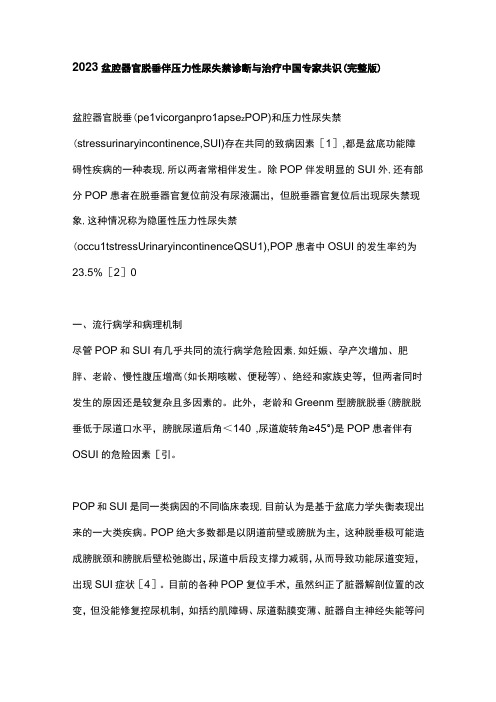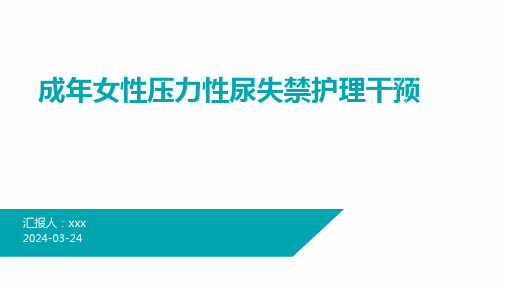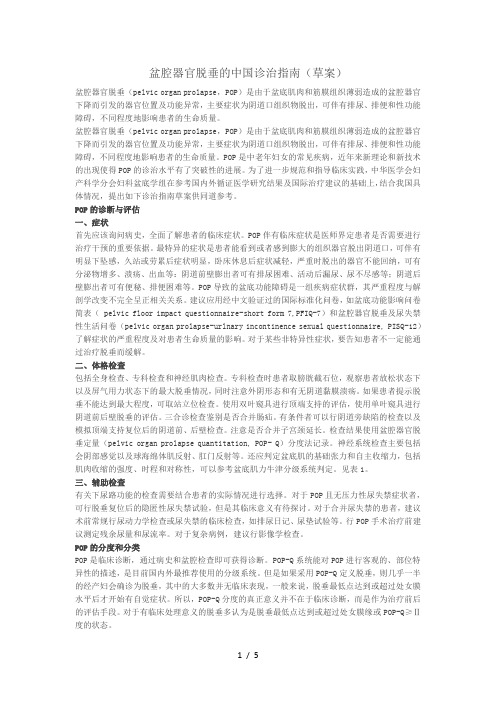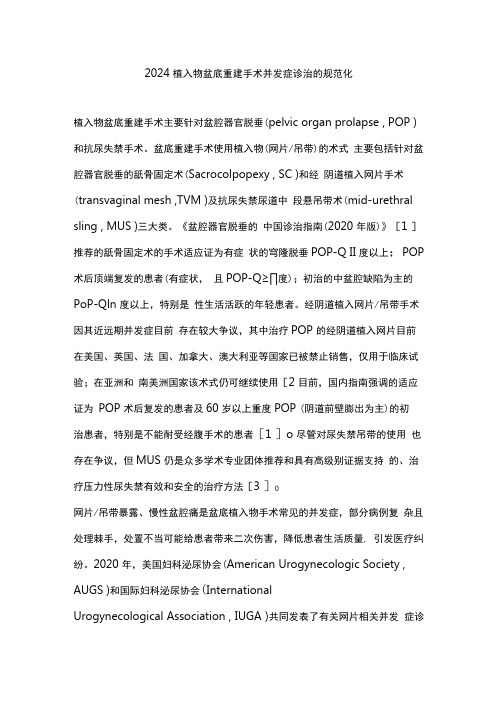2019 NICE女性尿失禁和盆腔器官脱垂管理指南(下)
2024版女性压力性尿失禁[2]
![2024版女性压力性尿失禁[2]](https://img.taocdn.com/s3/m/799d5657640e52ea551810a6f524ccbff021ca76.png)
续治疗提供依据。
制定个性化治疗方案
02
根据患者的具体情况,制定个性化的治疗方案,包括药物治疗、
物理治疗、手术治疗等。
定期随访与调整治疗方案
03
定期对患者进行随访,评估治疗效果,及时调整治疗方案,确
保治疗效果最大化。
17
患者教育与心理支持
1
提供疾病知识教育
向患者详细解释压力性尿失禁的病因、症状、治 疗方法等,提高患者对疾病的认识和理解。
尿道解剖结构异常
尿道长度、角度、括约肌功能等因素与压力性尿 失禁发病密切相关。
盆底肌肉功能减退
盆底肌肉对尿道支撑作用减弱,导致尿道关闭不 全。
神经调节机制障碍
中枢神经系统和周围神经对盆底肌肉和尿道括约 肌的调节功能异常。
2024/1/26
20
诊断技术发展趋势
2024/1/26
尿动力学检查
通过测量尿流率、膀胱压力等指标,客观评估尿道功能。
5
临床表现与诊断
2024/1/26
临床表现
患者主要表现为在腹压增加时出现不自主的尿液漏出,可伴有尿频、尿急等症状。 长期漏尿可导致会阴部潮湿、瘙痒、异味等问题,严重影响患者的生活质量。
诊断
医生通过详细询问病史、进行体格检查以及相关辅助检查(如尿常规、尿流动力学 检查等)来明确诊断。此外,还需评估患者的症状严重程度和对生活质量的影响程 度。
探索新的非手术治疗方法,如盆 底肌肉锻炼、生物反馈治疗、电 刺激治疗等。
手术治疗
改进手术方式和技巧,提高手术 疗效和安全性,如经阴道无张力 尿道中段悬吊术等。
个体化治疗
根据患者的具体病情和需求,制 定个体化的治疗方案,提高治疗
效果和生活质量。
盆腔脏器脱垂 PPT课件

第二十七章
盆底功能障碍性及生殖器 官损伤疾病
临床表现(2)
• 体征
✓ 常伴阴道前后壁膨出 ✓ 阴道黏膜增厚角化 ✓ 宫颈肥大并延长 ✓ 随脱垂子宫的下移,膀胱、输尿管下移与尿道开口形成正三角
区
37
第二十七章
盆底功能障碍性及生殖器 官损伤疾病
现在多采用盆腔器官脱垂定量分度法(POP-Q)
此系统分别利用阴道前壁、顶端、后壁上的各2个解剖指示 点与处女膜的关系来界定盆腔器官的脱垂程度。与处女 膜平行以0表示位于处女膜以上用负数表示,处女膜以下 则用正数表示,阴道前壁上的2个点分别以Aa和Ba点, 阴道顶端的2个点分别为C和D点,阴道后壁的Ap和Bp与 阴道前壁的2个 点是对应的,另外还包括阴裂(gh)的 长度,会阴体(pb)的 长度,阴道总长度TVL。
-3--+3之间
在无阴道脱垂时,此点位于-3㎝ 在子宫切除术后阴道完全外翻
第二十七章
盆底功能障碍性及生殖器 官损伤疾病
阴裂的长度(gh)为尿道外口中线到处女膜缘的中线距离 会阴体长度(pb)为阴裂的后端边缘到肛门中点距离 阴道总长度(TVL)为总阴道长度
41
第二十七章
盆底功能障碍性及生殖器 官损伤疾病
• 病因 阴道前壁主要由耻骨
宫颈韧带、膀胱宫颈筋膜和 泌尿生殖膈的深筋膜支持
17
第二十七章
盆底功能障碍性及生殖器 官损伤疾病
• 分类
✓ 膀胱膨出(cystocele)分娩、产后过早参加体力劳动未能很好 恢复,使膀胱底部失去支持力,这些因素导致与膀胱紧连的阴 道前壁向下膨出,在阴道口或外口处可见,称膀胱膨出
26
直肠膨出的检查
第二十七章
盆底功能障碍性及生殖器 官损伤疾病
2023盆腔器官脱垂伴压力性尿失禁诊断与治疗中国专家共识(完整版)

2023盆腔器官脱垂伴压力性尿失禁诊断与治疗中国专家共识(完整版)盆腔器官脱垂(pe1vicorganpro1apse z POP)和压力性尿失禁(stressurinaryincontinence,SUI)存在共同的致病因素[1],都是盆底功能障碍性疾病的一种表现,所以两者常相伴发生。
除POP伴发明显的SUI外,还有部分POP患者在脱垂器官复位前没有尿液漏出,但脱垂器官复位后出现尿失禁现象,这种情况称为隐匿性压力性尿失禁(occu1tstressUrinaryincontinenceQSU1),POP患者中OSUI的发生率约为23.5%[2]0一、流行病学和病理机制尽管POP和SUI有几乎共同的流行病学危险因素,如妊娠、孕产次增加、肥胖、老龄、慢性腹压增高(如长期咳嗽、便秘等)、绝经和家族史等,但两者同时发生的原因还是较复杂且多因素的。
此外,老龄和Greenm型膀胱脱垂(膀胱脱垂低于尿道口水平,膀胱尿道后角<140°,尿道旋转角≥45°)是POP患者伴有OSUI的危险因素[引。
POP和SUI是同一类病因的不同临床表现,目前认为是基于盆底力学失衡表现出来的一大类疾病。
POP绝大多数都是以阴道前壁或膀胱为主,这种脱垂极可能造成膀胱颈和膀胱后壁松弛膨出,尿道中后段支撑力减弱,从而导致功能尿道变短,出现SUI症状[4]。
目前的各种POP复位手术,虽然纠正了脏器解剖位置的改变,但没能修复控尿机制,如括约肌障碍、尿道黏膜变薄、脏器自主神经失能等问题,所以术后反而凸显了SUI的问题[5-6]o有学者对盆底应力性功能障碍疾病(pe1vicf1oorstressdysfunction,PFSD)发病机制进行的生物力学有限元精准力学研究结果显示,SUI与POP是密不可分的力学失衡疾病,同时也是全身整体机能衰退在盆底的表现,单纯纠治SUI或POP都无法获得良好的疗效,充分认识机体整体观和盆底PFSD后的力学失衡特点,进行整体功能复健指导和力学修复,才有可能获得最佳的疗效[7-8]o二、诊断与评估POP伴SUI的诊断主要依赖病史和专科查体,问卷和实验室检查方面与单纯的POP、SU1的诊断无明显区别。
女性压力性尿失禁的管理PPT课件

单切口微型吊带术(SIS)
该手术方法采用单一切口完成吊带放置,具有创伤小、恢复快的优点,适用于轻度至中度压力性尿失 禁患者。
并发症预防与处理策略
并发症预防
严格掌握手术适应症,选择合适的手术方法;术中精 细操作,避免损伤周围组织;术后加强护理,预防感 染。
采用标准化的生活质量问卷,评估患 者的生活质量及尿失禁对其造成的影 响。
心理状况评估
了解患者的心理状况,如焦虑、抑郁 等,以提供针对性的心理支持和干预 。
03
女性压力性尿失禁的非手术治 疗
盆底肌训练与生物反馈治疗
盆底肌训练
通过自主的、反复的盆底肌肉收缩和舒张,增强盆底 肌肉张力和弹性,改善尿道和膀胱功能,从而减少尿 失禁的发生。
临床表现及分型
临床表现
主要症状为在腹压增加时出现不自主溢尿,如咳嗽、 打喷嚏、大笑、跑步等。严重者可影响患者的生活质 量。
分型
根据症状严重程度,女性压力性尿失禁可分为轻度、 中度和重度。轻度患者仅在腹压增加时偶尔出现溢尿 ;中度患者在腹压增加时经常出现溢尿;重度患者则 在站立或行走时即可出现溢尿。
诊断标准与鉴别诊断
诊断标准
结合患者的病史、临床表现和尿动力学检查结果进行诊断。尿动力学检查可显 示充盈性膀胱测压时,在腹压增加而无逼尿肌收缩的情况下出现不随意漏尿。
鉴别诊断
主要与急迫性尿失禁、充溢性尿失禁和功能性尿失禁等相鉴别。急迫性尿失禁 表现为强烈的尿意和尿急;充溢性尿失禁是由于膀胱内尿液过多而引起的;功 能性尿失禁则与认知或行动障碍有关。
团体心理治疗
组织患者参加团体心理治 疗活动,通过互相支持、 分享经验,减轻心理压力 。
成年女性压力性尿失禁护理干预PPT课件

药物治疗
根据患者病情选择合适的药物进行治 疗。
心理干预
提供心理支持和疏导,帮助患者缓解 压力和焦虑情绪。
动态调整优化方案
定期评估效果
定期评估护理干预的效果,及时调整方案。
加强沟通与交流
与患者保持密切沟通,了解其需求和感受, 及时调整护理措施。
鼓励患者参与
鼓励患者积极参与护理过程,提出意见和建 议,共同制定优化方案。
定义与发病机制
定义
压力性尿失禁(Stress Urinary Incontinence, SUI)是指在腹压突然增高时, 如咳嗽、打喷嚏或大笑等,尿液不自主地自尿道外口渗漏的现象。
发病机制
压力性尿失禁的发病机制复杂,主要涉及尿道括约肌功能障碍、盆底肌肉松弛 、膀胱颈和近端尿道下移等因素。这些因素导致在腹压增加时,膀胱内压力超 过尿道闭合压,从而发生漏尿。
临床表现及分型
临床表现
压力性尿失禁的主要症状是在腹压增加时出现不自主溢尿, 如咳嗽、喷嚏、大笑等。严重情况下,患者可能在轻微活动 或平卧位改变时也会出现漏尿。
分型
根据症状严重程度,压力性尿失禁可分为轻度、中度和重度 。轻度患者仅在腹压增加时偶尔出现漏尿,中度患者在腹压 增加时经常出现漏尿,而重度患者则在轻微活动或平卧位时 也会出现漏尿。
保持大便通畅
戒烟限酒
建议患者保持大便通畅,避免便秘引起的 腹压增高。
提醒患者戒烟限酒,以改善全身健康状况, 有助于缓解尿失禁症状。
05
手术治疗方法介绍及术后康复 管理
手术方式选择依据和效果比较
选择依据
根据患者病情、年龄、生育要求、尿道括约肌功能等因素综合考虑,选择最合适的手术方式。
效果比较
不同的手术方式对压力性尿失禁的治疗效果有所不同,需结合患者具体情况和手术效果进行评估。
产后盆底康复护理对女性脏器脱垂及尿失禁改善情况的影响分析

产后盆底康复护理对女性脏器脱垂及尿失禁改善情况的影响分析【摘要】目的:讨论对女性脏器脱垂及尿失禁患者开展产后盆地康复护理的临床效果。
方法:选取2019年7月-2020年11月间于我院接受治疗的女性脏器脱垂及尿失禁患者100例,按入院时间分为对照组和观察组,对照组患者接受常规护理,观察组患者在此基础上接受产后盆地康复护理,对比两组患者PFDI-20量表评分、盆骨脱落与尿失禁情况及护理满意度。
结果:护理前,两组患者无明显差异(P>0.05),护理后,观察组患者PFDI-20量表中肛直肠症状得分、泌尿系统症状得分、盆腔器官脱垂得分明显低于对照组的得分;观察组脏器脱落情况(2.00%)、尿失禁情况(0.00%)改善程度均高于对照组(14.00%)、(12.00%);且观察组患者护理满意度(92.00%)明显高于对照组(70.00%),对比均具有统计学意义(P<0.05)。
结论:对女性脏器脱垂及尿失禁患者开展产后盆地康复护理,可有效改善脏器脱落情况和尿失禁情况,缓解患者临床症状,增加护理满意度,具有很高的实用价值。
【关键词】女性脏器脱垂;尿失禁;护理满意度;产后盆地康复护理女性盆地功能障碍性疾病是近几年来病发率较高的疾病,该病病发原理含多种原因,是一种以盆地功能薄弱为主要症状的病症[1],患者会出现盆腔结构缺陷,导致盆腔功能不能正常运行,临床表现为尿失禁和脏器脱落等病症[2],严重危害着患者的身体健康和生活质量。
针对该类情况,应采用科学高效的康复护理。
本研究中,通过对比接受不同护理的两组患者间护理效果,分析产后盆底康复护理对女性脏器脱垂及尿失禁患者的临床效果。
1.材料与分析1.1临床资料选取2019年7月-2020年11月间于我院接受治疗的女性脏器脱垂及尿失禁患者100例,按入院时间分为对照组和观察组,对照组中患者共50例,平均年龄为(27.62±1.39)岁,平均孕周为(37.51±1.06)周;观察组中患者共50例,平均年龄为(27.61±1.40)岁,平均孕周为(37.50±1.05)周,两组患者均无药物实用禁忌,且均为单胎妊娠,排除其他疾病,与家属均签署知情协议,一般资料与患病基础对比无明显差异(P>0.05),可进行对比。
盆腔器官脱垂的中国诊治指南

盆腔器官脱垂的中国诊治指南(草案)盆腔器官脱垂(pelvic organ prolapse,POP)是由于盆底肌肉和筋膜组织薄弱造成的盆腔器官下降而引发的器官位置及功能异常,主要症状为阴道口组织物脱出,可伴有排尿、排便和性功能障碍,不同程度地影响患者的生命质量。
盆腔器官脱垂(pelvic organ prolapse,POP)是由于盆底肌肉和筋膜组织薄弱造成的盆腔器官下降而引发的器官位置及功能异常,主要症状为阴道口组织物脱出,可伴有排尿、排便和性功能障碍,不同程度地影响患者的生命质量。
POP是中老年妇女的常见疾病,近年来新理论和新技术的出现使得POP的诊治水平有了突破性的进展。
为了进一步规范和指导临床实践,中华医学会妇产科学分会妇科盆底学组在参考国内外循证医学研究结果及国际治疗建议的基础上,结合我国具体情况,提出如下诊治指南草案供同道参考。
POP的诊断与评估一、症状首先应该询问病史,全面了解患者的临床症状。
POP伴有临床症状是医师界定患者是否需要进行治疗干预的重要依据。
最特异的症状是患者能看到或者感到膨大的组织器官脱出阴道口,可伴有明显下坠感,久站或劳累后症状明显,卧床休息后症状减轻,严重时脱出的器官不能回纳,可有分泌物增多、溃疡、出血等:阴道前壁膨出者可有排尿困难、活动后漏尿、尿不尽感等;阴道后壁膨出者可有便秘、排便困难等。
POP导致的盆底功能障碍是一组疾病症状群,其严重程度与解剖学改变不完全呈正相关关系。
建议应用经中文验证过的国际标准化问卷,如盆底功能影响问卷简表( pelvic floor impact questionnaire-short form 7,PFIQ-7)和盆腔器官脱垂及尿失禁性生活问卷(pelvic organ prolapse-urlnary incontinence sexual questionnaire, PISQ-12)了解症状的严重程度及对患者生命质量的影响。
2019 CUA指南:神经源性下尿路功能障碍的诊断,管理和监测

2019 CUA指南:神经源性下尿路功能障碍的诊断,管理和监测导读2019年6月,加拿大泌尿外科协会(CUA)发布了神经源性下尿路功能障碍的诊断,管理和监测指南,主要帮助泌尿外科医生识别高风险神经源性下尿路功能障碍,以及提供正确的管理和监测措施。
现将重点内容编译整理如下,希望为大家临床工作带来帮助!国际尿失禁协会将神经源性下尿路功能障碍(NLUTD)定义为神经控制机制紊乱引起的下尿路功能障碍。
NLUTD的常见病因包括:脊髓损伤(SCI)、多发性硬化(MS)和脊髓脊膜膨出。
其他病因包括:帕金森、脑血管意外、创伤性脑损伤、脑或脊髓肿瘤、马尾综合征、横贯性脊髓炎、多系统萎缩、骨盆神经损伤以及糖尿病。
图1 NLUTD根据原发病变位置分类诊断NLUTD的诊断主要包括两方面的内容,即排尿功能障碍是否为神经源性及确定神经源性排尿功能障碍的类型。
要诊断某人患有NLUTD,必须有明确或强烈怀疑的神经系统疾病。
提示神经疾病的潜在症状包括多发性硬化、马尾综合征和隐匿性神经管缺损的诊断前症状。
治疗辅助膀胱引流方法包括清洁间歇性导尿、尿道或耻骨上导尿,应根据患者运动功能、解剖局限性、膀胱特征、既往泌尿系并发症和生活质量,制定个体化方案(推荐等级A级,证据等级3级)。
抗胆碱能药物抗毒蕈碱药物应提供给尿动力学检查为神经源性逼尿肌过度活动(NDO)或具有SCI和膀胱过度活动症(OAB)症状的患者(推荐等级A级,证据等级1a级)。
无论患者是否使用辅助膀胱引流,都应考虑使用抗毒蕈碱药物(推荐等级C级,证据等级4级)。
B3肾上腺素能激动剂对于有OAB和NLUTD症状的患者来说,米拉贝隆可能是抗胆碱能药的有效替代品,但在该人群中需进一步验证尿动力学变化(推荐等级C级,证据等级4级)。
推荐:为改善OAB和NDO症状,减少尿急尿失禁和降低逼尿肌压力,口服剂量递增的抗毒蕈碱药是NLUTD患者的一线药物治疗方案。
(推荐等级A级,证据等级1a级)。
盆腔器官脱垂中国诊治指南(草案)

盆腔器官脱垂的中国诊治指南(草案)盆腔器官脱垂(pelvic organ prolapse,POP)是由于盆底肌肉和筋膜组织薄弱造成的盆腔器官下降而引发的器官位置及功能异常,主要症状为阴道口组织物脱出,可伴有排尿、排便和性功能障碍,不同程度地影响患者的生命质量。
盆腔器官脱垂(pelvic organ prolapse,POP)是由于盆底肌肉和筋膜组织薄弱造成的盆腔器官下降而引发的器官位置及功能异常,主要症状为阴道口组织物脱出,可伴有排尿、排便和性功能障碍,不同程度地影响患者的生命质量。
POP是中老年妇女的常见疾病,近年来新理论和新技术的出现使得POP的诊治水平有了突破性的进展。
为了进一步规范和指导临床实践,中华医学会妇产科学分会妇科盆底学组在参考国内外循证医学研究结果及国际治疗建议的基础上,结合我国具体情况,提出如下诊治指南草案供同道参考。
POP的诊断与评估一、症状首先应该询问病史,全面了解患者的临床症状。
POP伴有临床症状是医师界定患者是否需要进行治疗干预的重要依据。
最特异的症状是患者能看到或者感到膨大的组织器官脱出阴道口,可伴有明显下坠感,久站或劳累后症状明显,卧床休息后症状减轻,严重时脱出的器官不能回纳,可有分泌物增多、溃疡、出血等:阴道前壁膨出者可有排尿困难、活动后漏尿、尿不尽感等;阴道后壁膨出者可有便秘、排便困难等。
POP导致的盆底功能障碍是一组疾病症状群,其严重程度与解剖学改变不完全呈正相关关系。
建议应用经中文验证过的国际标准化问卷,如盆底功能影响问卷简表( pelvic floor impact questionnaire-short form 7,PFIQ-7)和盆腔器官脱垂及尿失禁性生活问卷(pelvic organ prolapse-urlnary incontinence sexual questionnaire, PISQ-12)了解症状的严重程度及对患者生命质量的影响。
中华医学会压力性尿失禁指南(2019版)要点解读

中华医学会压力性尿失禁指南(2019版)要点解读宋奇翔;廖利民【期刊名称】《实用妇产科杂志》【年(卷),期】2022(38)6【摘要】尿失禁是泌尿外科门诊的一类常见疾病。
它不同程度地影响着各年龄阶段患者的生活质量和身心健康。
随着社会经济水平和文化教育程度的不断提高,人们对健康生活的追求日益迫切,尿失禁问题也越来越多地受到了民众和学者们的重视。
根据尿失禁症状和病因的不同,可将其分为压力性尿失禁(stress urinary incontinence,SUI)、急迫性尿失禁(urgency urinary incontinence,UUI)、充盈性尿失禁、夜间遗尿和尿瘘等。
其中SUI是最为常见的类型之一,主要表现为患者在咳嗽、打喷嚏、大笑、走路、运动等引起腹压增加的情况下出现尿液不自主地从尿道口漏出的症状。
【总页数】3页(P419-421)【作者】宋奇翔;廖利民【作者单位】上海交通大学医学院附属仁济医院泌尿外科;中国康复研究中心北京博爱医院泌尿外科【正文语种】中文【中图分类】R694.54【相关文献】1.女性压力性尿失禁的手术治疗:美国泌尿外科学会(AUA)/尿流动力学、女性盆底医学和泌尿生殖道重建学会(SUFU)指南解读2.两大权威机构2016版心力衰竭r 诊治指南的十大亮点r——中华医学会心电生理和起搏分会副主任委员、北京医院心血管r内科主任杨杰孚教授解读2016ESC及ACC/AHA指南3.国内外女性压力性尿失禁相关指南非手术管理内容解读4.2017年AUA/SUFU手术治疗女性压力性尿失禁指南解读5.2021年波兰妇产科医师协会“女性压力性尿失禁管理指南”解读因版权原因,仅展示原文概要,查看原文内容请购买。
女性产后压力性尿失禁最佳治疗科普

女性产后压力性尿失禁最佳治疗科普压力性尿失禁(SUI)是一种在女性中日益普遍的健康问题,其特点是在腹压突然增加时,如大笑、咳嗽、打喷嚏或体力活动时,尿液会不受控制地泄漏。
尽管SUI的社交尴尬和生活质量下降让许多女性感到困扰,但幸运的是,有多种方法可以有效地预防和治疗这一问题。
本文将介绍SUI的治疗方法,旨在帮助女性更好地管理和改善她们的盆底健康。
第一部分:背景介绍:SUI是一种常见的女性盆底障碍,其发病率逐渐上升。
该疾病通常由盆底肌肉功能受损引起,而分娩过程中对盆底结构的影响是其主要原因之一。
孕期的体重增加、激素水平变化和分娩都可以导致盆底肌肉的松弛和损伤,从而引发SUI。
此外,SUI的发生还受到吸烟、饮食习惯等生活方式因素的影响。
对于产后女性来说,这是一个特殊的时期,需要特别关注盆底健康,以提高生活质量和健康状况。
第二部分:生活方式的干预•孕期体重控制和产后健康减重:孕期体重管理对于减轻盆底压力的重要性不可忽视。
孕期合理控制体重的增长可以降低盆底肌肉的不适和压力。
产后,采取健康的减重方法,例如坚持适度的运动和平衡饮食,以恢复身体的健康状态。
•戒烟和减少咖啡因摄入:吸烟和高咖啡因摄入可能会导致尿道括约肌的刺激和膀胱过度兴奋,增加SUI的风险。
戒烟和减少咖啡因摄入可以有助于减轻这些影响。
•改善饮食习惯:饮食习惯对SUI的发生和发展有一定的影响。
避免便秘和过度进食高脂肪、辛辣或刺激性食物有助于降低腹压,减轻SUI的症状。
第三部分:盆底肌训练盆底肌训练是一种有效的预防和治疗SUI的方法,它可以加强盆底肌肉,改善尿液控制。
以下是一些盆底肌训练的方法:•Kegel运动:Kegel运动是一种针对盆底肌肉的有效锻炼方法。
首先,在排空膀胱后,仰卧在床上,尽量放松身体。
然后,有意识地收缩盆底肌肉,想象着憋尿的感觉,保持收缩5秒钟左右,然后放松。
重复这个动作多次,每天进行锻炼。
逐渐增加收缩的时间和强度,从3秒到5秒,再到10秒。
2024植入物盆底重建手术并发症诊治的规范化

2024植入物盆底重建手术并发症诊治的规范化植入物盆底重建手术主要针对盆腔器官脱垂(pelvic organ prolapse , POP )和抗尿失禁手术。
盆底重建手术使用植入物(网片/吊带)的术式主要包括针对盆腔器官脱垂的舐骨固定术(Sacrocolpopexy , SC )和经阴道植入网片手术(transvaginal mesh ,TVM )及抗尿失禁尿道中段悬吊带术(mid-urethral sling , MUS )三大类。
《盆腔器官脱垂的中国诊治指南(2020年版)》[1 ]推荐的舐骨固定术的手术适应证为有症状的穹隆脱垂POP-Q II度以上;POP 术后顶端复发的患者(有症状,且POP-Q≥∏度);初治的中盆腔缺陷为主的PoP-Qln度以上,特别是性生活活跃的年轻患者。
经阴道植入网片/吊带手术因其近远期并发症目前存在较大争议,其中治疗POP的经阴道植入网片目前在美国、英国、法国、加拿大、澳大利亚等国家已被禁止销售,仅用于临床试验;在亚洲和南美洲国家该术式仍可继续使用[2 目前,国内指南强调的适应证为POP术后复发的患者及60岁以上重度POP (阴道前壁膨出为主)的初治患者,特别是不能耐受经腹手术的患者[1 ]o尽管对尿失禁吊带的使用也存在争议,但MUS仍是众多学术专业团体推荐和具有高级别证据支持的、治疗压力性尿失禁有效和安全的治疗方法[3 ]0网片/吊带暴露、慢性盆腔痛是盆底植入物手术常见的并发症,部分病例复杂且处理棘手,处置不当可能给患者带来二次伤害,降低患者生活质量, 引发医疗纠纷。
2020年,美国妇科泌尿协会(American Urogynecologic Society , AUGS )和国际妇科泌尿协会(InternationalUrogynecological Association , IUGA )共同发表了有关网片相关并发症诊治流程的联合立场声明[4 ], 2021年中华医学会妇产科学分会妇科盆底学组也制定了相应的中国专家共识[5 ]供同道们借鉴。
女性压力性尿失禁诊断和治疗指南(试行)

女性压力性尿失禁诊断和治疗指南(试行)作者:中华医学会妇产科学分会妇科盆底学组压力性尿失禁(stress urinary incontinence,SUI)是指喷嚏、咳嗽、大笑或运动等腹压增高时出现不自主的尿液自尿道口漏出。
症状表现为喷嚏、咳嗽、运动等腹压增高时不自主漏尿。
体征是在增加腹压时,能观察到尿液不白主地从尿道口漏出。
尿动力学检查表现为充盈性膀胱测压时,在腹压增高而无逼尿肌收缩的情况下出现不随意漏尿。
中国成年女性SUI患病率高达18.9%,在50~59岁年龄段,SUI患病率最高,为28.0%。
目前,国际上对尿失禁的治疗日益规范,中华医学会妇产科学分会妇科盆底学组参考国际上相关的尿失禁治疗指南,结合我国国情,经研究讨论制定了我国SUI诊断和治疗指南,目的是指导疾病的诊治。
该指南将根据实际工作需要和研究进展不断修订,加以完善。
一、诊断SUI的病理生理机制包括:(l)膀胱颈及近端尿道下移;(2)尿道黏膜的封闭功能减退;(3)尿道固有括约肌功能下降;(4)支配挖尿组织结构的神经系统功能障碍。
SUI的诊断主要依据主观症状和客观检查,并需除外其他类型的尿失禁及膀胱疾病。
(一)SUI的诊断基本病史和检查:(1)病史:包括全身情况,SUI症状,漏尿次数及严重程度,泌尿系统的其他症状及其他病史(既往病史、月经生育史、生活习惯、活动认知能力、并发疾病和使用药物、盆腔手术史和放疗史等).患者预期的治疗效果。
(2)查体:包括一般状态,全身检查,专科检查和神经系统检查。
专科检查应了解外生殖器有无盆腔器官脱垂及程度;外阴部有无长期感染所引起的异味、皮疹;双合诊了解子宫位置、大小和盆底肌收缩力等;肛门指诊检查肛门括约肌肌力及有无直肠膨出。
神经系统检查包括会阴感觉、球海绵体肌反射及肛门括约肌肌力的检查。
初步评估:压力试验及指压试验,尿常规检查;尿常规检查阳性或存在下尿路症状者行中段尿培养检查,尿培养检查阳性者针对药物敏感试验进行抗生素治疗。
- 1、下载文档前请自行甄别文档内容的完整性,平台不提供额外的编辑、内容补充、找答案等附加服务。
- 2、"仅部分预览"的文档,不可在线预览部分如存在完整性等问题,可反馈申请退款(可完整预览的文档不适用该条件!)。
- 3、如文档侵犯您的权益,请联系客服反馈,我们会尽快为您处理(人工客服工作时间:9:00-18:30)。
2019 NICE女性尿失禁和盆腔器官脱垂管理指南(下)2019年4月,英国国家卫生与临床优化研究所(NICE)发布了女性尿失禁和盆腔器官脱垂的管理指南,主要内容涵盖了年龄≥18岁女性尿失禁和盆腔器官脱垂的评估和管理,同时也包含相关手术并发症的管理。
本指南内容分两次报道,现为第二部分,主要内容为盆腔器官脱垂的评估、非手术疗法和外科疗法。
盆腔器官脱垂的评估For women presenting in primary care with symptoms or an incidental finding of vaginal prolapse: Take a history to include symptoms of prolapse, urinary, bowel and sexual function. Do an examination to rule out a pelvic mass or other pathology and to document the presence of prolapse. Discuss the woman's treatment preferences with her, and refer if needed.对于在初级保健中出现症状或偶然发现阴道脱垂的女性:请记录包括脱垂、尿路、肠道和性功能症状。
进行检查以排除盆腔肿块或其他病状,并记录脱垂的存在。
与患者讨论其治疗偏好,如果需要的话可以参考。
For women referred to secondary care for an unrelated condition who have incidental symptoms or an incidental finding of vaginal prolapse, consider referral to a clinician with expertise in prolapse.对于二级医疗机构出现偶发阴道脱垂无法治疗的女性,请转诊到脱垂专科医疗机构。
For women who are referred for specialist evaluation of vaginal prolapse, perform an examination to: assess and record the presence and degree of prolapse of the anterior, central and posterior vaginal compartments of the pelvic floor, using the POP-Q (Pelvic Organ Prolapse Quantification) system. Assess the activity of the pelvic floor muscles. Assess for vaginal atrophy. Rule out a pelvic mass or other pathology.转诊至阴道脱垂专科机构的女性,请进行以下检查:使用POP-Q(盆腔器官脱垂量表)评估,并记录盆底前、中、后阴道腔室脱垂的存在情况和严重程度。
评估盆底肌肉活动。
评估阴道萎缩程度。
排除盆腔肿块或其他病状。
For women with pelvic organ prolapse, consider using a validated pelvic floor symptom questionnaire to aid assessment and decision making. Do not routinely perform imaging to document the presence of vaginal prolapse if a prolapse is detected by physical examination. If the woman has symptoms of prolapse that are not explained by findings from a physical examination, consider repeating the examination with the woman standing or squatting, or at a different time.对于盆腔器官脱垂女性,请使用经验证的盆底症状问卷帮助评估和决策。
如经体检发现脱垂,切勿例行影像检查以证实阴道脱垂的存在。
如果女性有脱垂症状,但不能用体检结果解释,可考虑再次检查,让女性站立或蹲下,或在不同时间点检查。
Consider investigating the following symptoms in women with pelvic organ prolapse: urinary symptoms that are bothersome and for which surgical intervention is an option. Aymptoms of obstructed defaecation or faecal incontinence. Pain. Symptoms that are not explained by examination findings.研究脱垂女性的以下症状:可选择手术治疗的严重泌尿症状。
大便阻塞或大便失禁症状。
疼痛。
检查结果无法解释的症状。
非手术疗法Discuss management options with women who have pelvic organ prolapse, including no treatment, non-surgical treatment and surgical options, taking into account: The woman's preferences, site of prolapse, lifestyle factors, comorbidities, including cognitive or physical impairments, age, desire for childbearing, previous abdominal or pelvic floor surgery, benefits and risks of individual procedures.在选择治疗方案时(包括不处理、非手术疗法和手术方案),应综合考虑:女性偏好、脱垂部位、生活方式、合并症(包括认知或身体损伤)、年龄、生育欲望、腹部或盆底手术史、手术收益和风险。
Lifestyle modifification losing weight, if the woman has a BMI greater than 30 kg/m2. Minimising heavy lifting. Preventing or treating constipation.生活方式调整如果女性BMI指数>30 kg/m2,则建议减肥。
减轻日常负重。
预防或治疗便秘。
Pelvic floor muscle training Consider a programme of supervised pelvic floor muscle training for at least 16 weeks as a first option for women with symptomatic POP-Q (Pelvic Organ Prolapse Quantification) stage 1 or stage 2 pelvic organ prolapse. If the programme is beneficial, advise women to continue pelvic floor muscle training afterwards.盆底肌肉训练对于POP-Q评分1期或2期的症状性脱垂女性,应将盆底肌肉训练至少16周作为首选方案。
如果该方案有益,则建议女性继续盆底肌肉训练。
Consider a vaginal pessary for women with symptomatic pelvic organ prolapse, alone or in conjunction with supervised pelvic floor muscle training. Refer women who have chosen a pessary to a urogynaecology service if pessary care is not available locally.子宫托对于症状性脱垂女性,考虑使用阴道子宫托(单独或与盆底肌肉训练一起使用)。
如果在当地无法获得子宫托护理,可转诊到泌尿妇科医疗机构。
Before starting pessary treatment: consider treating vaginalatrophy with topical oestrogen. Explain that more than 1 pessary fitting may be needed to find a suitable pessary. Discuss the effect of different types of pessary on sexual intercourse. Describe complications including vaginal discharge, bleeding, difficulty removing pessary and pessary expulsion. Explain that the pessary should be removed at least once every 6 months to prevent serious pessary complications.在采用子宫托治疗前:应考虑使用局部雌激素治疗阴道萎缩。
向患者解释可能需要多个子宫托,以找到合适的一个。
讨论不同类型的子宫托对性交的影响。
描述并发症,包括阴道分泌物、出血、子宫托移除困难和排出。
解释子宫托应至少每6个月取出一次,以防止严重的子宫托并发症。
Offer women using pessaries an appointment in a pessary clinic every 6 months if they are at risk of complications, for example because of a physical or cognitive impairment that might make it difficult for them to manage their ongoing pessary care. [2019]若使用子宫托女性有并发症风险,如因身体或认知障碍,难以掌控正在进行的子宫托护理,请每6个月在子宫托诊所就诊。
